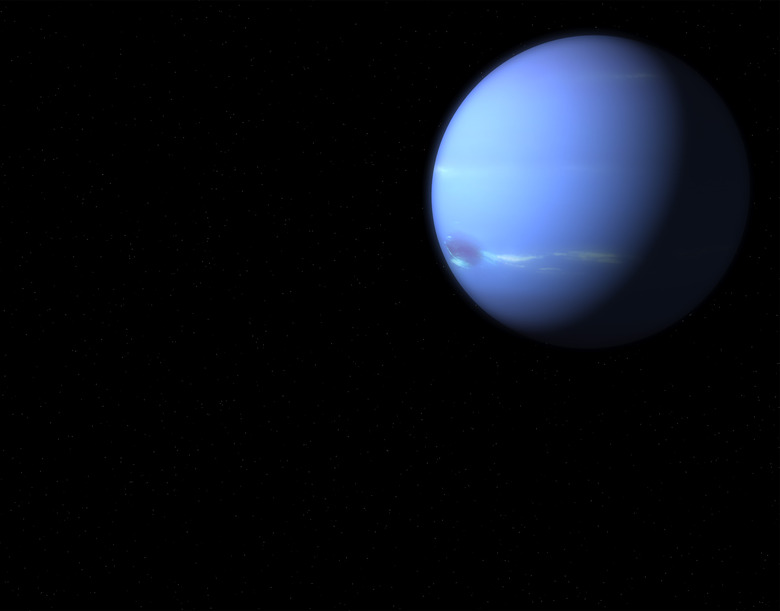Can You Stand On Neptune?
Neptune may look like a smooth blue marble floating in space, but it's really a large gas planet upon which you cannot stand. The blue "surface" you see through a telescope is the cloud cover that hides the rest of the planet. Orbiting the sun at a distance of about 4.5 billion kilometers, or 2.8 billion miles, Neptune is also one of the most distant planets.
Neptune Dissected
Neptune Dissected
The only solid part of Neptune is its rocky core made of ice and gas. If you could slice the planet in half, you'd see its other layers. The mantle made of ammonia, water and methane ice, sits above the core. Helium, methane and hydrogen rise above the mantle while the cloud top layer high above the planet covers everything. Temperatures at Neptune's core can reach 5,127 Celsius, or 9,260 degrees Fahrenheit. While it's not as large as Saturn or Jupiter, Neptune is still the solar system's third-largest planet.
Moons, Rings and Orbits
Moons, Rings and Orbits
Saturn's rings may captivate people, but Neptune has rings too. Those six rings are simply fainter and more difficult to see. Thirteen moons circle the planet and an additional one awaits confirmation of discovery. If you could stand on Neptune, you'd experience days that lasted about 16 hours. However, you would not live to see one year pass because it takes 165 Earth years for Neptune to circle the sun. The planet's mean radius is 24,622 kilometers, or 15,299 miles.
Standing Near Neptune
Standing Near Neptune
If you really wanted to travel over 4 billion miles to stand near Neptune, you could head to Proteus. One of Neptune's largest moons, Proteus has a solid surface that is covered with craters. It is also one of the solar system's darkest objects – it only reflects 6 percent of the light that hits it. Triton, Neptune's largest moon, is one of the solar system's coldest objects. Also covered with craters, it has a thin atmosphere consisting of methane and nitrogen.
Atmospheric Wonders
Atmospheric Wonders
Methane helps give Neptune it's characteristic blue-green color. Because this gas absorbs red light, the planet appears blue when you view it. Uranus also has a methane atmosphere, but its colors aren't as vivid as Neptune's. Scientists believe that an additional unknown gas makes Neptune more colorful than Uranus. Even if you could stand on Neptune, you'd need to hold onto a solid object to keep from flying away. Winds on the planet can reach up to 2,520 kilometers, or 1,5750 mph.
References
- NASA: Solar System Exploration- Planets- Neptune- Overview
- NASA: Solar System Exploration- Multimedia- Gallery- Neptune's Interior
- Space.Com: What Is Neptune Made Of?
- NASA: Solar System Exploration- Planets- Neptune- Moons- Proteus- Overview
- NASA: Solar System Exploration- Planets- Neptune- Moons- Triton- Overview
- Encyclopedia Britannica: Neptune (Planet) – The Atmosphere
Cite This Article
MLA
Lee, Kevin. "Can You Stand On Neptune?" sciencing.com, https://www.sciencing.com/can-you-stand-on-neptune-12731865/. 25 February 2014.
APA
Lee, Kevin. (2014, February 25). Can You Stand On Neptune?. sciencing.com. Retrieved from https://www.sciencing.com/can-you-stand-on-neptune-12731865/
Chicago
Lee, Kevin. Can You Stand On Neptune? last modified March 24, 2022. https://www.sciencing.com/can-you-stand-on-neptune-12731865/
